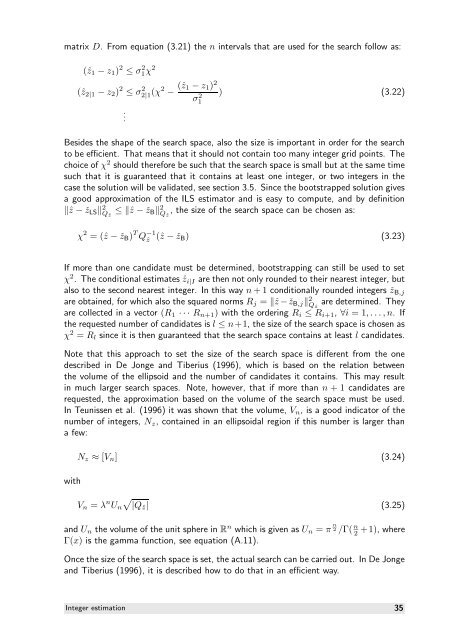The GNSS integer ambiguities: estimation and validation
The GNSS integer ambiguities: estimation and validation
The GNSS integer ambiguities: estimation and validation
Create successful ePaper yourself
Turn your PDF publications into a flip-book with our unique Google optimized e-Paper software.
matrix D. From equation (3.21) the n intervals that are used for the search follow as:<br />
(ˆz1 − z1) 2 ≤ σ 2 1χ 2<br />
(ˆz 2|1 − z2) 2 ≤ σ 2 2|1 (χ2 − (ˆz1 − z1) 2<br />
) (3.22)<br />
.<br />
σ 2 1<br />
Besides the shape of the search space, also the size is important in order for the search<br />
to be efficient. That means that it should not contain too many <strong>integer</strong> grid points. <strong>The</strong><br />
choice of χ2 should therefore be such that the search space is small but at the same time<br />
such that it is guaranteed that it contains at least one <strong>integer</strong>, or two <strong>integer</strong>s in the<br />
case the solution will be validated, see section 3.5. Since the bootstrapped solution gives<br />
a good approximation of the ILS estimator <strong>and</strong> is easy to compute, <strong>and</strong> by definition<br />
ˆz − ˇzLS2 Qˆz ≤ ˆz − ˇzB 2 , the size of the search space can be chosen as:<br />
Qˆz<br />
χ 2 = (ˆz − ˇzB) T Q −1<br />
ˆz (ˆz − ˇzB) (3.23)<br />
If more than one c<strong>and</strong>idate must be determined, bootstrapping can still be used to set<br />
χ2 . <strong>The</strong> conditional estimates ˆz i|I are then not only rounded to their nearest <strong>integer</strong>, but<br />
also to the second nearest <strong>integer</strong>. In this way n + 1 conditionally rounded <strong>integer</strong>s ˇzB,j<br />
are obtained, for which also the squared norms Rj = ˆz − ˇzB,j2 are determined. <strong>The</strong>y<br />
Qˆz<br />
are collected in a vector (R1 · · · Rn+1) with the ordering Ri ≤ Ri+1, ∀i = 1, . . . , n. If<br />
the requested number of c<strong>and</strong>idates is l ≤ n+1, the size of the search space is chosen as<br />
χ2 = Rl since it is then guaranteed that the search space contains at least l c<strong>and</strong>idates.<br />
Note that this approach to set the size of the search space is different from the one<br />
described in De Jonge <strong>and</strong> Tiberius (1996), which is based on the relation between<br />
the volume of the ellipsoid <strong>and</strong> the number of c<strong>and</strong>idates it contains. This may result<br />
in much larger search spaces. Note, however, that if more than n + 1 c<strong>and</strong>idates are<br />
requested, the approximation based on the volume of the search space must be used.<br />
In Teunissen et al. (1996) it was shown that the volume, Vn, is a good indicator of the<br />
number of <strong>integer</strong>s, Nz, contained in an ellipsoidal region if this number is larger than<br />
a few:<br />
with<br />
Nz ≈ [Vn] (3.24)<br />
Vn = λ n <br />
Un |Qˆz| (3.25)<br />
<strong>and</strong> Un the volume of the unit sphere in Rn which is given as Un = π n<br />
2 /Γ( n<br />
2 +1), where<br />
Γ(x) is the gamma function, see equation (A.11).<br />
Once the size of the search space is set, the actual search can be carried out. In De Jonge<br />
<strong>and</strong> Tiberius (1996), it is described how to do that in an efficient way.<br />
Integer <strong>estimation</strong> 35
















